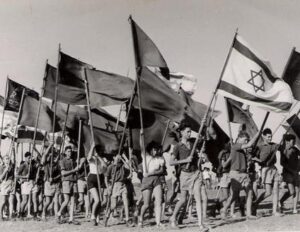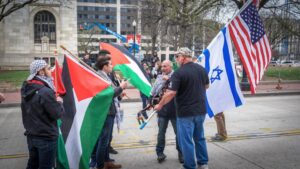The Israeli and Palestinian conflict has persisted for over a century, manifesting as one of the most enduring and complex disputes in modern history. What began as a territorial and national struggle has evolved into a broader ideological clash, one that entangles religion, history, geopolitics, and identity.
The Israeli and Palestinian Conflict
The geographic area now known as Israel and the Palestinian Territories has seen thousands of years of Jewish presence. According to archaeological and historical records, the Kingdom of Israel was established over 3,000 years ago.
Jerusalem has stood as a central cultural and spiritual capital of the Jewish people for millennia. After successive occupations by the Babylonians, Persians, Greeks, and Romans, the Jewish people were scattered, but never fully severed from the land.
Following the Bar Kokhba Revolt (132–135 AD), Roman Emperor Hadrian renamed Judea to “Syria Palestina” in an intentional move to erase the Jewish identity of the region. Over the centuries, various empires—Byzantine, Islamic Caliphates, Crusaders, Mamluks, Ottomans—ruled over this land, but no sovereign nation-state named “Palestine” ever existed during those eras.
Zionist Revival and Early Arab Resistance
In the late 19th century, the rise of nationalism in Europe coincided with the birth of modern Zionism. As European Jews faced growing persecution, the movement sought to reestablish a national homeland in the historic Land of Israel.
The First Aliyah (immigration wave) began in the 1880s, with Jewish pioneers purchasing land legally—often from absentee Ottoman landlords—and developing agricultural settlements. During this period, Arab population growth in the area also increased due to economic opportunities created by Jewish development.
By the early 20th century, the demographic makeup and political status of the region became a point of tension. Arab leaders viewed the influx of Jews with increasing hostility, despite the fact that many Jewish communities had lived continuously in cities like Jerusalem, Safed, and Tiberias for centuries.
Tensions intensified after the fall of the Ottoman Empire and the division of the Middle East between colonial powers.
Colonial Promises and the Birth of Modern Tensions
One of the most pivotal origins of The Israeli and Palestinian conflict lies in the contradictory promises made by European powers during World War I. The British, through the McMahon-Hussein Correspondence (1915–1916), hinted at Arab independence in exchange for revolting against the Ottomans.
Simultaneously, the 1916 Sykes-Picot Agreement secretly divided the Middle East between Britain and France. In 1917, Britain issued the Balfour Declaration, supporting the establishment of a “national home for the Jewish people” in Palestine.
These overlapping commitments sowed confusion and mistrust. When the British Mandate for Palestine was approved by the League of Nations in 1922, tensions erupted between Arab and Jewish communities.
Arab riots against Jews in 1920, 1921, and most violently in 1929 (notably in Hebron and Safed) further hardened divisions. The Arab Higher Committee rejected every partition or compromise proposal, including the 1937 Peel Commission and the 1947 UN Partition Plan, both of which offered Arabs a state alongside a Jewish one.
The 1948 War and the Refugee Issue
With the end of British rule in 1948, the Jewish leadership declared the independence of the State of Israel. Immediately, five Arab nations—Egypt, Syria, Jordan, Lebanon, and Iraq—launched a military invasion. Though outnumbered, Israel survived and expanded its territory beyond the UN’s proposed borders.
Approximately 750,000 Arab residents fled or were expelled during the conflict. Israel claims many left at the urging of Arab leaders who promised a swift return after victory, while Palestinian narratives emphasize forced displacement.
The resulting refugee crisis became central to The Israeli and Palestinian conflict. However, it’s important to note that a similar number of Jews—around 850,000—were expelled from Arab countries in the years following Israel’s independence.
While Israel absorbed these Jewish refugees, Arab countries largely confined Palestinian refugees to camps, refusing to integrate them or grant them citizenship, using them instead as a political lever against Israel.
Rise of the PLO and the Internationalization of the Conflict
The formation of the Palestinian Liberation Organization (PLO) in 1964 marked a significant shift. The group was explicitly created not to liberate the West Bank and Gaza—which were under Jordanian and Egyptian control at the time—but to destroy Israel. The PLO’s charter denied Israel’s right to exist and declared armed struggle as the only path to “liberation.”
Under Yasser Arafat’s leadership, the PLO launched numerous attacks on Israeli civilians, airplanes, and international targets. The 1972 Munich massacre of Israeli athletes by the PLO-linked Black September group shocked the world and placed The Israeli and Palestinian conflict at the center of global terrorism concerns.
Israel responded with operations like “Wrath of God” and “Entebbe,” demonstrating its policy of preemptive self-defense.
Despite numerous peace efforts, including the 1993 Oslo Accords—which granted limited autonomy to the Palestinian Authority—negotiations repeatedly failed. The Second Intifada (2000–2005), sparked after the collapse of the Camp David talks, brought horrific waves of suicide bombings, which decimated Israeli public trust in the peace process.
Gaza, Hamas, and Iranian Influence
The 2006 Palestinian legislative elections brought Hamas—a designated terrorist group by the U.S., EU, and Israel—to power. After a violent coup in 2007, Hamas took over Gaza, turning the territory into an Iranian-backed militant enclave. Rockets began flying into southern Israel, triggering repeated wars in 2008–09, 2012, 2014, and beyond.
The most recent flare-up in 2023 demonstrated Hamas’s continued strategy of using civilian infrastructure—schools, hospitals, mosques—as shields for military assets.
Their aim is twofold: provoke Israeli retaliation and weaponize Palestinian civilian suffering for global condemnation. This asymmetry of warfare lies at the heart of modern phases of The Israeli and Palestinian conflict.
Meanwhile, Iran’s support for Hamas, Hezbollah, and Islamic Jihad has regionalized the conflict. These groups serve as Iranian proxies, aiming not just at Israel but also at undermining moderate Arab states that have moved toward normalization, such as the UAE, Bahrain, and Morocco under the Abraham Accords.
Obstacles to Peace: Leadership, Ideology, and International Politics
Efforts to resolve The Israeli and Palestinian conflict have failed primarily due to entrenched ideological positions. Palestinian leadership has consistently rejected offers that include recognition of Israel as a Jewish state or relinquishing claims to the “right of return” for descendants of refugees. Hamas, for its part, remains openly committed to Israel’s destruction as stated in its founding charter.
Western nations, including the United States and EU, often exacerbate the conflict through inconsistent policies—condemning Israeli self-defense while ignoring Palestinian incitement and corruption.
The Biden administration’s relaxation of sanctions on Iran has funneled billions of dollars into terrorist networks that target Israel. Meanwhile, UN bodies continue to disproportionately censure Israel, often overlooking far graver human rights abuses worldwide.
The Human Cost and the Need for Moral Clarity
While The Israeli and Palestinian conflict is often viewed through a political or strategic lens, the human cost cannot be ignored. Innocent civilians on both sides suffer deeply. However, there is a moral asymmetry: one side openly glorifies martyrdom and rewards terror, while the other strives—imperfectly—to uphold democratic norms under siege.
Calls for ceasefires or “both sides” equivalency often ignore this asymmetry. A just resolution requires recognition of historical truths, firm rejection of terrorism, and international accountability—not only for Israel’s actions, but for the Palestinian leadership’s decades-long sabotage of peace.
Conclusion: Toward an Honest Reckoning
The Israeli and Palestinian conflict cannot be resolved through slogans or simplistic narratives. It requires an honest reckoning with history, acknowledgment of legitimate Jewish ties to the land, and a clear-eyed view of the strategic manipulations by Palestinian leaders.
So long as organizations like Hamas thrive on perpetual warfare and international sympathy without accountability, peace will remain elusive.
Until Palestinian leadership embraces genuine coexistence over confrontation, Israel will continue to defend its right to exist—sometimes alone, often vilified, but always determined. The world must decide whether it stands with democratic self-determination or with those who weaponize suffering for power.
Lessons for the Free World
The Israeli and Palestinian conflict is not just a regional issue—it is a frontline in the broader battle between democratic values and militant extremism. As jihadist ideologies seek to destabilize societies far beyond the Middle East, Israel’s struggle offers sobering lessons about deterrence, resilience, and moral clarity.
you can read more about this topic here and read about other top topics here.



